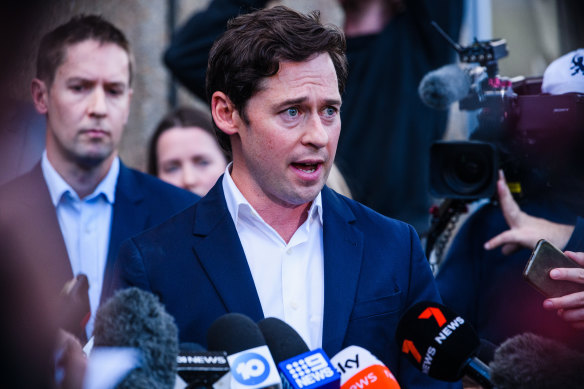The Age sweeps Walkley Awards including journalism’s biggest prize, the Gold Walkley
By Staff reporters
Investigative journalists Nick McKenzie, David Marin-Guzman and Ben Schneiders have won the highest honour in Australian journalism, the Gold Walkley, for revealing the nation’s most powerful union had been infiltrated by bikies and organised criminals.
The Building Bad investigation, published by The Age, ran for several months and exposed widespread allegations of corruption and intimidation within the union. It resulted in the sacking of several high-profile union leaders, and the federal government ultimately placed the union into administration.

Nick McKenzie led the Building Bad reporting team that won the Gold Walkley.Credit: James Brickwood
The series, backed by The Age, The Sydney Morning Herald, The Australian Financial Review and 60 Minutes, collected two awards at the 69th Walkley Awards for Excellence in Journalism event held at the International Convention Centre in Sydney on Tuesday – the Gold Walkley and the award for best long-form current affairs story on television.
The Age and Herald staff swept the awards with 10 Walkleys spanning investigative journalism, photography, news reporting, opinion writing, cartoons and design, from 20 nominations – more than any other news organisation in Australia.
The Age’s Nick McKenzie and Michael Bachelard, and 60 Minutes’ Amelia Ballinger won the award for scoop of the year for their investigation into a powerful home affairs secretary’s secret efforts to exert political influence.
As well as the award for best scoop, the trio also took the prize for best short-form current affairs story in the television/video category for the same story.
Nick Moir was named press photographer of the year for his portfolio of work published in The Sydney Morning Herald and The Age.
Investigative reporter Carrie Fellner won the print/text news report category alongside Matt Davidson, Matthew Absalom-Wong and Michael Evans for covering the unfolding environmental and health crisis of the impacts of “forever chemicals” known as PFAS.
Fellner was also part of the winning team in the documentary category alongside Katrina McGowan, Janine Hosking and Mat Cornwell for the iKandy Films and Stan film How To Poison A Planet.
Arts writer Linda Morris and investigative reporter Eryk Bagshaw won the specialist/beat reporting category for their work exposing mining billionaire Gina Rinehart’s campaign to have a portrait removed from the National Gallery of Australia.
The Age’s visual stories team won the explanatory journalism award for their story comparing Olympic champions from 100 years ago to today’s athletes, titled Faster, higher, stronger.
David Leser won the commentary, analysis, opinion and critique category for a series of columns about the war in Gaza.
Cathy Wilcox won the prize for cartoon of the year with her work titled Break glass.
Last month, Melbourne-based photographer Christopher Hopkins won the portrait prize award for an image captured for Good Weekend.
The Age’s haul of 10 awards this year compares with six in 2023, as well as two special awards – one honouring media freedom presented to McKenzie and Chris Masters, and the other to sports journalist and broadcaster Caroline Wilson for outstanding contribution to journalism.
“There is no newsroom in this country more dedicated to holding the powerful to account than The Age,” editor Patrick Elligett said.
“This result is recognition of that fact. It is also due recognition for The Age’s Nick McKenzie, who, as the most prolific Walkley winner in history and one of this country’s greatest-ever journalists is a thoroughly deserved winner of the Gold Walkley.”
Executive editor Luke McIlveen said: “This has been an incredible year for the unrivalled journalism at the Herald and The Age.
“This is deserved recognition for the journalists, editors, photojournalists and artists who serve our readers every day.”
Patrick Elligett sends an exclusive newsletter to subscribers each week. Sign up to receive his Note from the Editor.